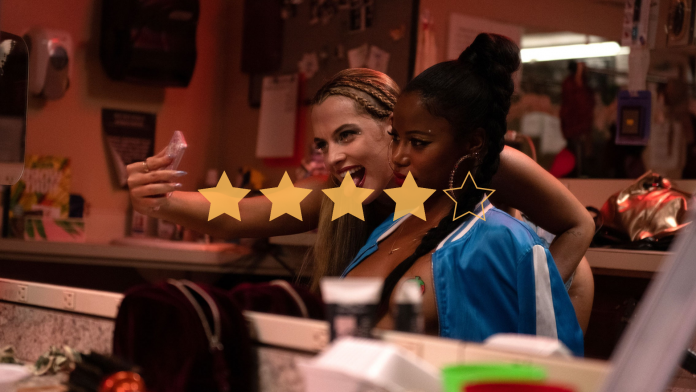@_zolarmoon’s infamous 148-tweet long Twitter thread has been adapted into a suspensfully dark tale in ‘Zola’.
★★★★✰
I remember being 14 and reading @_zolarmoon’s Twitter thread. It was arguably one of the most chaotic stories I had seen on the site at the time (I’d only been using Twitter about 18 months at this point, and I’ve been traumatised more since). After its viral success, the story caught the eye of Hollywood and five years later Janicza Bravo’s Zola is now out in cinemas.
Following Az’iah ‘Zola’ King in her “hoe trip” turned human trafficking tale, Zola sees the adaptation of the almost unbelievable experience of the Hooters waitress and stripper. Accompanied by friend-turned-enemy Stefani (Riley Keough), a pimp called X (Colman Domingo), and Stefani’s emotionally unstable boyfriend Derrek (Nicholas Braun), Zola (Taylour Paige) ends up spending less time dancing in a club or sunbathing and more time on dark winding roads in the sunshine state of Florida.
Even if you go into the film knowing the major plot points from the Twitter thread, the film is still able to create a new degree of suspense and brings a notably darker tone to the story. Bravo expressed that this film isn’t one meant to mimic the (debatably) humorous tone of the original Twitter thread. Zola’s story lost its deeply unsettling reality in the gloss of internet virality; Bravo’s film reminds us that this was ultimately a case of sex trafficking by making the audience into an uncomfortable witness to the trauma inflicted upon Zola.
Still granting much-needed comic relief in the harrowing tale, the film makes no mistake in warning you that it is going to be one of danger and tension. There are omens on the car drive down to Florida that the story will go south—the “Jesus Saves” sign, the white cross, and finally the Confederate flag. The repeated reel of men paying for sex entering into a hotel room in act 2 highlights how the story is far from a raucous striper story like Hustlers. But the final act of the film ultimately hammers home how much danger Zola is in.
We are reminded of Zola’s specific vulnerabilities as a Black woman working in the sex industry in America. In less than 15-minutes, we see the lack of power she has due to both her gender and race; the two women are left at the mercy and direction of men and to then drive by an incident of police brutality. This peaks in a final sequence that shows how Black women are often pawns in society, especially in the games of men. And in this case, it is all to save a white woman who is viewed as more valuable. There is no way that any part of Zola’s identity can be detached from the plot, with Bravo adding in contextual information that can’t be ignored in the same way it could be when reading the Twitter thread.
The two female leads absolutely shine in the film, with Taylour Paige stealing scenes as Zola without saying a word. Zola’s voice often isn’t there—she is more of a witness in the background of the unfolding chaos, only interjecting with voice-over narration when necessary. Yet Paige doesn’t let her disappear in scenes, filling silent shots with more physical acting and mannerisms. When Zola does speak, Paige makes her voice count.
Riley Keough as Stefani initially feels awkward and uncomfortable, with the speech and mannerisms of the character making it seem as if Keough had been miscast. Yet, with time, it becomes apparent that Keough is doing an excellent job. Stefani’s persona is a caricature of Black culture, a permeant black-face that is jarring and offensive, and the audience’s discomfort testimony to how well Keough commits to the role.
Coleman Domingo’s X is less convincing; the artistic choice to have his character flick between a very suspect sounding ‘African’ accent and an American one is never explained and falls quite flat in comparison to Keough’s boldness. Nicholas Braun’s Derrek is slightly better but again falls into the shadow of the two women who take on their roles so well.
Throughout, the film pays dues to its online origins while still bringing the artistry and beauty expected of an A24 film. Frequent tweet notification noises in the background, a scene that appears to be shot on an iPhone, and the screen flickering like an iPhone camera when photos are taken by the characters remind viewers of the fact that the story would have been lost if it were not for modern digital habits and platforms. Everything else is equally intentional—from the remnant flecks of glitter eyeshadow that remain stuck on Zola’s face as a legacy of the traumatic night before, to the long winding shots of road that see us travel further into the story, into Florida, and away from anywhere recognisable to Zola.
Sticking mainly to the plot of the original tale, the widely anticipated movie lives up to the suspense. A tale that is a whiplash read has become a slow-burning, suspenseful tale under Bravo’s direction. Memorable for not only the chaos but also its beautiful cinematography, and bringing greater sociocultural commentary to an initially linear and sparse narrative, Zola is a must-watch for this summer.
The Verdict
An ugly tale that is beautifully shot, Janicza Bravo’s Zola retells a story that is initially 148-tweet long into an 85-minute watch. An ode to viral internet culture without being delusional about the dark reality of the sex work industry.
Words by Celia Bergin
Support The Indiependent
We’re trying to raise £200 a month to help cover our operational costs. This includes our ‘Writer of the Month’ awards, where we recognise the amazing work produced by our contributor team. If you’ve enjoyed reading our site, we’d really appreciate it if you could donate to The Indiependent. Whether you can give £1 or £10, you’d be making a huge difference to our small team.
